 |
MATRICES:Matrix Representation, ADDITION AND SUBTRACTION OF MATRICES |
| << Matrix and its dimension Types of matrix:TYPICAL APPLICATIONS |
| RATIO AND PROPORTION MERCHANDISING:Punch recipe, PROPORTION >> |
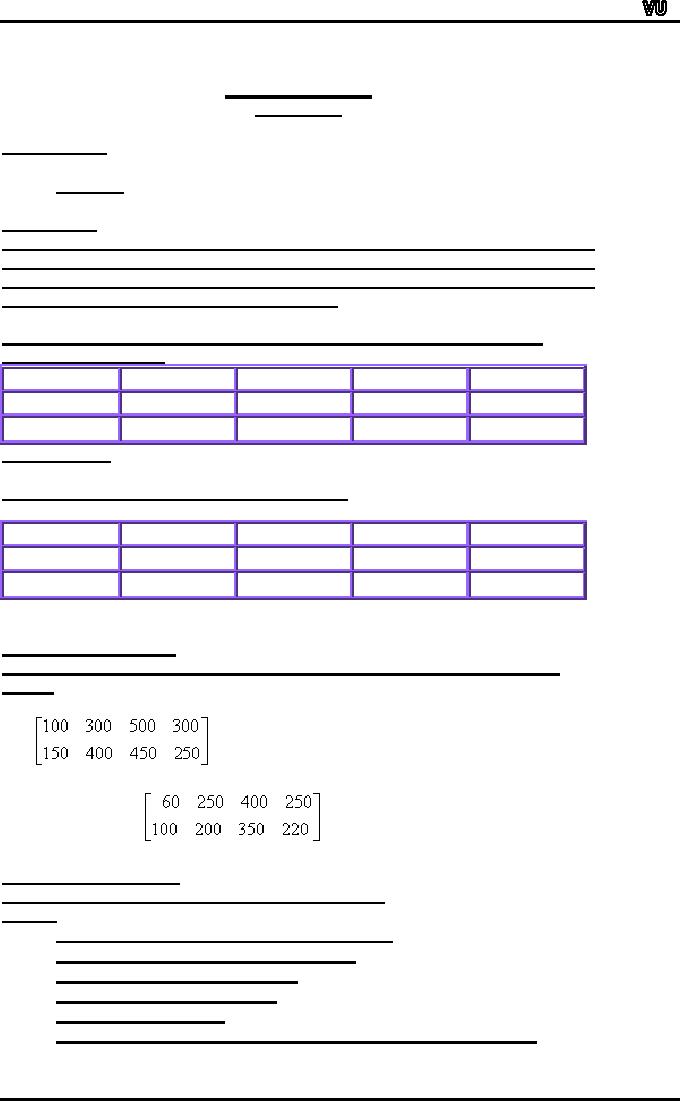
MTH001
Elementary Mathematics
LECTURE #
20
MATRICES
OBJECTIVES
The
objectives of the lecture
are to learn about:
�
Matrices
EXAMPLE
1
An
athletic clothing company
manufactures T-shirts and
sweat shirts in
four
differents
sizes, small, medium, large,
and x-large. The company
supplies two
major
universities, the U of R and
the U of S. The tables below
show
September's
clothing order for each
university
University
of S's September Clothing
Order
S
M
L
XL
T-shirts
100
300
500
300
sweat
shirts
150
400
450
250
University
of R's September Clothing
Order.
S
M
L
XL
T-shirts
60
250
400
250
sweat
shirts
100
200
350
200
Matrix
Representation
The
above information can be
given by two matrices S and
R as shown
below.
S=
R=
MATRIX
OPERATIONS
The
matrix operations can be
summarized as under:
�
Organize
and interpret data using
matrices
�
Use
matrices in business
applications
�
Add
and subtract two
matrices
�
Multiply
a matrix by a scalar
�
Multiply
two matrices
�
Interpret
the meaning of the elements
within a product
matrix
Page
132
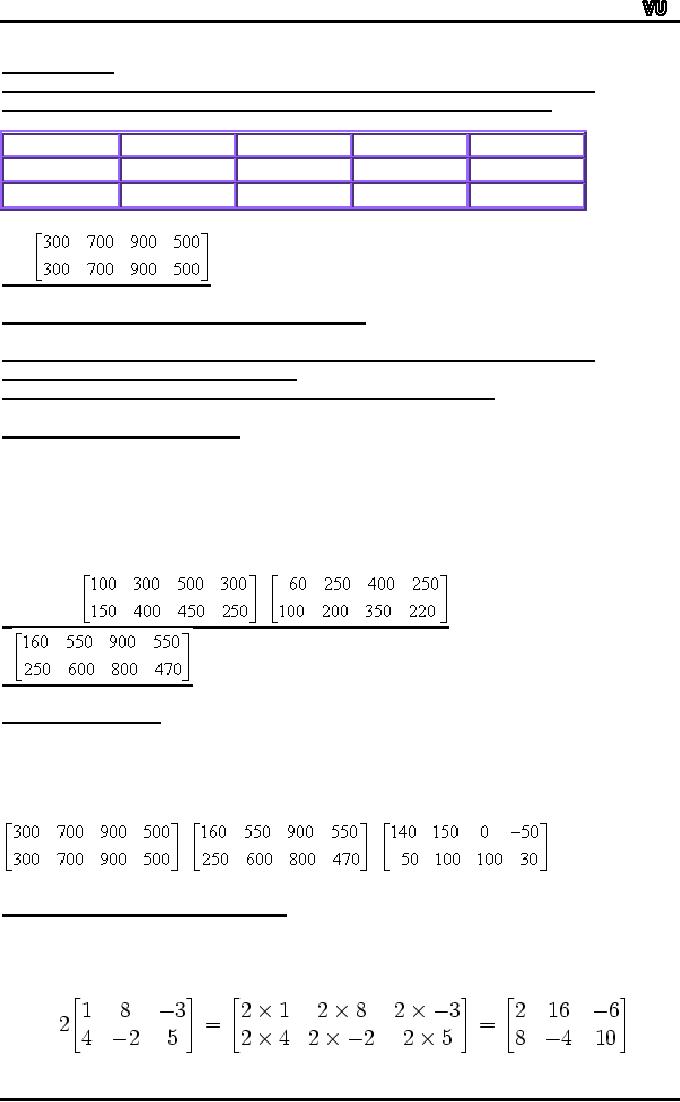
MTH001
Elementary Mathematics
PRODUCTION
The
clothing company production in
preparation for the
universities'
September
orders is shown by the table
and corresponding matrix P
below.
S
M
L
XL
T-shirts
300
700
900
500
sweat
shirts
300
700
900
500
P=
ADDITION
AND SUBTRACTION OF
MATRICES
The
sum or difference of two matrices is
calculated by adding or subtracting
the
corresponding
elements of the
matrices.
To
add or subtract matrices,
they must have the
same dimensions.
PRODUCTION
REQUIREMENT
Since
the U of S ordered 100 small
T-shirts and the U of R
ordered 60, then
althogether
160 small T-shirts are
required to supply both
universities. Thus, to
calculate
the total number of T-shirts
and sweat shirts required to
supply both
universities,
add the corresponding
elements of the two order
matrices as shown
below.
+
=
OVERPRODUCTION
Since
the company produced 300
small T-shirts and the
received orders for
only
160
small T-shirts, then the
company produced 140 small
T-shirts too many.
Thus,
to determine the company's
over-production, subtract the
corresponding
elements
of the total order matrix
from the production matrix
as shown below.
-
=
MULTIPLY
A MATRIX BY A SCALAR
Given
a matrix A
and
a number c,
the scalar
multiplication cA
is
computed by multiplying the scalar
c
by
every element of A
.For
example:
Page
133
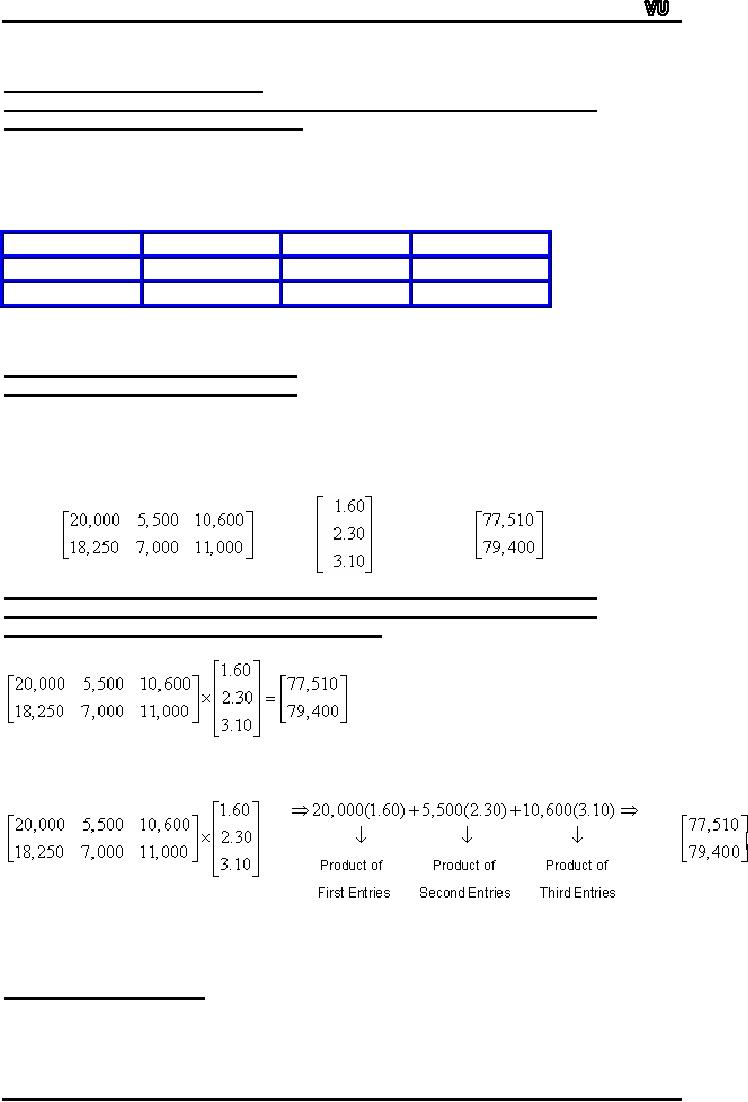
MTH001
Elementary Mathematics
MULTIPLICATION
OF MATRICES
To
understand the reasoning
behind the definition of
matrix multiplication,
let
us consider the following
example.
Competing
Companies, A and B, sell
juice in 591 mL, 1 L and 2 L
plastic bottles
at
prices of Rs.1.60, Rs.2.30
and Rs.3.10, respectively.
The table below
summarises
the sales for the
two companies during the
month of July.
591mL
1L
2L
Company
A
20,000
5,500
10,600
Company
B
18,250
7,000
11,000
What
is total revenue of Company
A?
What
is total revenue of Company
B?
Matrices
may be used to illustrate
the above
information.
As
shown at the right, the
sales can be written
as
a
2X3 matrix, S, the selling
prices can be written as a
column matrix, P, and
the
total
revenue for each company
can be expressed as a column
matrix, R.
S=
R=
P=
Since
revenue is calculated by multiplying
the number of sales by
the
selling
price, the total revenue
for each company is found by
taking the
product
of the sales matrix and
the price matrix.
Consider
how the first row of
matrix S and the single
column P lead to the
first
entry of R.
With
the above in mind, we define
the product of a row and a
column to be the
number
obtained by multiplying corresponding
entries (first by first,
second by
second,
and so on) and adding
the results.
MULTIPLICATION
RULES
Page
134
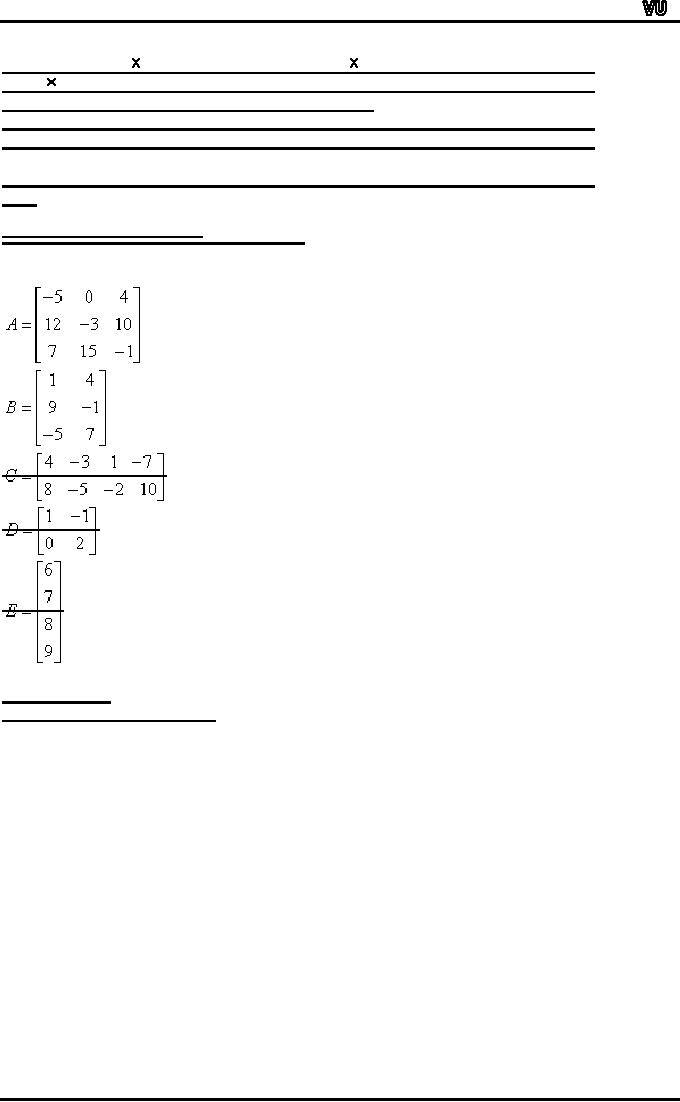
MTH001
Elementary Mathematics
If
matrix A is a m n matrix and
matrix B is a n p matrix, then
the product AB is
the
m p matrix whose entry in
the i-th row and the
j-th column is the product
of
the
i-th row of matrix A and the
j-th row of matrix B.
The
product of a row and a column is
the number obtained by
multiplying
corresponding
elements (first by first,
second by second, and so
on).
To
multiply matrices, the
number of columns of A must
equal the number of
rows
of
B.
MULTIPLICATION
RULES For
example
Given
the matrices below, decide
if the indicated product
exists. And, if the
product
exists, determine the
dimensions of the product
matrix.
MULTIPLICATION
CHECKS
The
table below gives a summary
whether it is possible to multiply
two matrices.
It
may be noticed that the
product of matrix A and
matrix B is possible as
the
number
of columns of A are equal to
the number of rows of B. The
product BA is
not
possible as the number of
columns of b are not equal
to rows of A.
Page
135
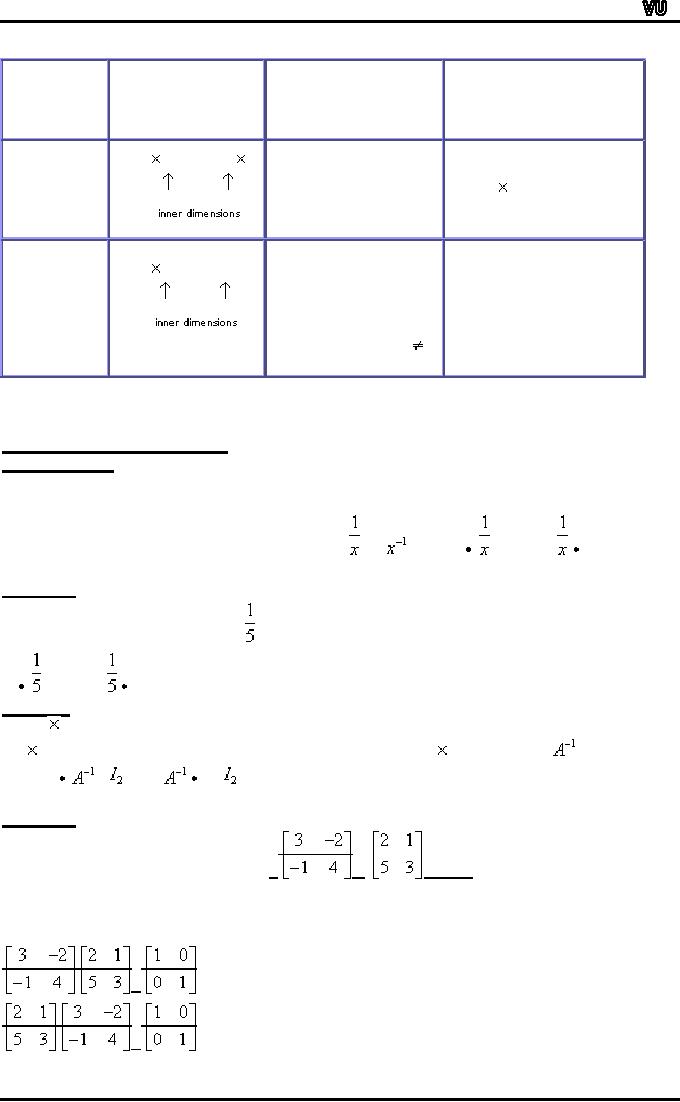
MTH001
Elementary Mathematics
Does
a product exist?
Dimensions
of (Is
it possible to multiply Dimensions
of
Product
the
Matrices
the
given
Product
Matrix
matrices
in this order?)
Yes,
the product exists
A=3
3 B=3 2
since
the
inner
dimensions match
32
AB
(#
of columns of A
= #
of
rows of B).
No,
the product does
B=3
2
A
=
3�3
not
exist
since
the inner
dimensions
do
n/a
BA
not
match
(#
of columns of B
#
of
rows of A).
MULTIPLICATIVE
INVERSES
Real
Numbers
Two
non-zero real numbers are
multiplicative inverses of each
other if their
products,
in both orders, is 1.
Thus,
the
multiplicative inverse of a real
number, x is
or
since
x
=
1 and
x
=
1.
Example:
The
multiplicative inverse of 5 is
since
5
=
1 and
5=1
Matrices
Two
2 2 matrices are inverses of
each other if their
products, in both orders,
is
a
2 2 identity matrix. Thus,
the multiplicative inverse of a 2 2
matrix, A is
since
A
=
and
A=
Example:
⎡
3
-1⎤
The
multiplicative inverse of a
matrix,
is
since
is ⎢
-5 2 ⎥
⎣
⎦
=
=
Page
136

MTH001
Elementary Mathematics
-1⎤
⎡ 1
0⎤
⎡2
1⎤ ⎡ 3
⎥
= ⎢ 0
1⎥
⎢5
3⎥ ⎢-5
2⎦
⎣
⎣
⎦⎣
⎦
-1⎤
⎡2
⎡3
1⎤ ⎡
1
0⎤
=
⎢-5
2
⎥
⎢5
3⎥ ⎢
0
1⎥
⎣
⎦⎣
⎦⎣
⎦
Page
137
Table of Contents:
- Recommended Books:Set of Integers, SYMBOLIC REPRESENTATION
- Truth Tables for:DE MORGAN’S LAWS, TAUTOLOGY
- APPLYING LAWS OF LOGIC:TRANSLATING ENGLISH SENTENCES TO SYMBOLS
- BICONDITIONAL:LOGICAL EQUIVALENCE INVOLVING BICONDITIONAL
- BICONDITIONAL:ARGUMENT, VALID AND INVALID ARGUMENT
- BICONDITIONAL:TABULAR FORM, SUBSET, EQUAL SETS
- BICONDITIONAL:UNION, VENN DIAGRAM FOR UNION
- ORDERED PAIR:BINARY RELATION, BINARY RELATION
- REFLEXIVE RELATION:SYMMETRIC RELATION, TRANSITIVE RELATION
- REFLEXIVE RELATION:IRREFLEXIVE RELATION, ANTISYMMETRIC RELATION
- RELATIONS AND FUNCTIONS:FUNCTIONS AND NONFUNCTIONS
- INJECTIVE FUNCTION or ONE-TO-ONE FUNCTION:FUNCTION NOT ONTO
- SEQUENCE:ARITHMETIC SEQUENCE, GEOMETRIC SEQUENCE:
- SERIES:SUMMATION NOTATION, COMPUTING SUMMATIONS:
- Applications of Basic Mathematics Part 1:BASIC ARITHMETIC OPERATIONS
- Applications of Basic Mathematics Part 4:PERCENTAGE CHANGE
- Applications of Basic Mathematics Part 5:DECREASE IN RATE
- Applications of Basic Mathematics:NOTATIONS, ACCUMULATED VALUE
- Matrix and its dimension Types of matrix:TYPICAL APPLICATIONS
- MATRICES:Matrix Representation, ADDITION AND SUBTRACTION OF MATRICES
- RATIO AND PROPORTION MERCHANDISING:Punch recipe, PROPORTION
- WHAT IS STATISTICS?:CHARACTERISTICS OF THE SCIENCE OF STATISTICS
- WHAT IS STATISTICS?:COMPONENT BAR CHAR, MULTIPLE BAR CHART
- WHAT IS STATISTICS?:DESIRABLE PROPERTIES OF THE MODE, THE ARITHMETIC MEAN
- Median in Case of a Frequency Distribution of a Continuous Variable
- GEOMETRIC MEAN:HARMONIC MEAN, MID-QUARTILE RANGE
- GEOMETRIC MEAN:Number of Pupils, QUARTILE DEVIATION:
- GEOMETRIC MEAN:MEAN DEVIATION FOR GROUPED DATA
- COUNTING RULES:RULE OF PERMUTATION, RULE OF COMBINATION
- Definitions of Probability:MUTUALLY EXCLUSIVE EVENTS, Venn Diagram
- THE RELATIVE FREQUENCY DEFINITION OF PROBABILITY:ADDITION LAW
- THE RELATIVE FREQUENCY DEFINITION OF PROBABILITY:INDEPENDENT EVENTS